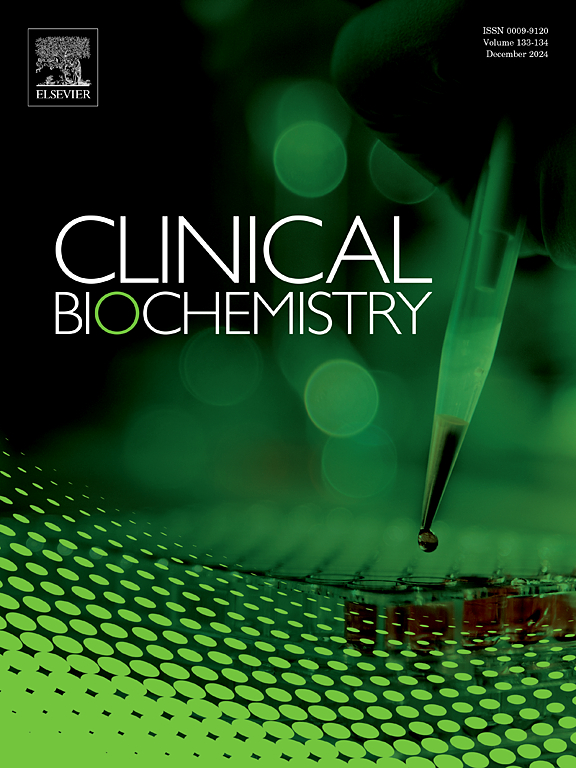Amikacin therapeutic drug monitoring: Evaluation of therapy performance and analytical techniques in a developing country setting
IF 2.5
3区 医学
Q2 MEDICAL LABORATORY TECHNOLOGY
引用次数: 0
Abstract
Introduction
Healthcare systems face several challenges, with microbial infections being one of the main concerns. Therapeutic drug monitoring (TDM) is a strategy that has been encouraged to optimize antimicrobial regimens, particularly those with significant toxicity and narrow therapeutic indices, such as amikacin (AMK). We aimed to evaluate AMK concentrations of patients in a non-routine TDM setting and compare the performance of immunoassay and chromatography methods for routine clinical use.
Material and Methods
In this prospective study, peak (Cmax) and trough (Cmin) plasma samples were collected from 39 adult patients and quantified by ultra-performance liquid chromatography coupled with mass spectrometry (UPLC-MS/MS). Relevant clinical information was collected from medical records. AMK concentrations and clinical data were analyzed to evaluate therapy performance and influencing factors. In addition, fluorescence polarized immunoassay (FPIA) and UPLC-MS/MS were compared with Passing-Bablok regression and Bland-Altman plot analysis.
Results
AMK concentrations varied widely, with a median Cmax of 41.40 µg/mL (interquartile range [IQR] 27.60 – 56.75 µg/mL) and a median Cmin of 1.87 µg/mL (IQR 0.7 – 6.19 µg/mL). A high proportion of patients (83.1 %) failed to achieve the Cmax therapeutic target, while 31.7 % failed to achieve the Cmin therapeutic target. Overall, elderly patients and those with reduced renal function had higher Cmax target attainment, while the same groups had lower Cmin target attainment. The method comparison showed a mean difference of 1.54 % (limits of agreement −42.46 % to 45.54 %) in measured concentrations, with good correlation and no constant or proportional differences.
Conclusion
Many patients failed to reach the Cmax target and were at risk of treatment failure, although adequate Cmin was achieved more often. TDM with dose adjustments could improve AMK therapy, but further research is needed.
阿米卡星治疗药物监测:发展中国家环境中治疗效果和分析技术的评价。
卫生保健系统面临着几个挑战,微生物感染是主要问题之一。治疗性药物监测(TDM)是一种被鼓励用于优化抗菌方案的策略,特别是那些具有显著毒性和狭窄治疗指标的方案,如阿米卡星(AMK)。我们的目的是评估非常规性TDM患者的AMK浓度,并比较常规临床使用的免疫测定和色谱法的性能。材料和方法:本前瞻性研究采集39例成人患者的血浆峰(Cmax)和谷(Cmin)样品,采用超高效液相色谱-质谱联用(UPLC-MS/MS)进行定量分析。从病历中收集相关临床信息。分析AMK浓度及临床资料,评价治疗效果及影响因素。此外,荧光极化免疫分析法(FPIA)和UPLC-MS/MS与pass - bablok回归和Bland-Altman图分析进行比较。结果:AMK浓度变化很大,中位Cmax为41.40µg/mL(四分位数范围[IQR] 27.60 ~ 56.75µg/mL),中位Cmin为1.87µg/mL (IQR 0.7 ~ 6.19µg/mL)。高达83.1%的患者未能达到Cmax治疗目标,31.7%的患者未能达到Cmin治疗目标。总体而言,老年患者和肾功能下降患者的Cmax目标达到率较高,而同一组的Cmin目标达到率较低。方法比较表明,测定浓度的平均差异为1.54%(一致性限为42.46% ~ 45.54%),相关性良好,无恒定或比例差异。结论:许多患者未能达到Cmax目标,存在治疗失败的风险,尽管达到足够的Cmin的情况较多。调整剂量的TDM可以改善AMK治疗,但需要进一步的研究。
本文章由计算机程序翻译,如有差异,请以英文原文为准。
求助全文
约1分钟内获得全文
求助全文
来源期刊

Clinical biochemistry
医学-医学实验技术
CiteScore
5.10
自引率
0.00%
发文量
151
审稿时长
25 days
期刊介绍:
Clinical Biochemistry publishes articles relating to clinical chemistry, molecular biology and genetics, therapeutic drug monitoring and toxicology, laboratory immunology and laboratory medicine in general, with the focus on analytical and clinical investigation of laboratory tests in humans used for diagnosis, prognosis, treatment and therapy, and monitoring of disease.
 求助内容:
求助内容: 应助结果提醒方式:
应助结果提醒方式:


